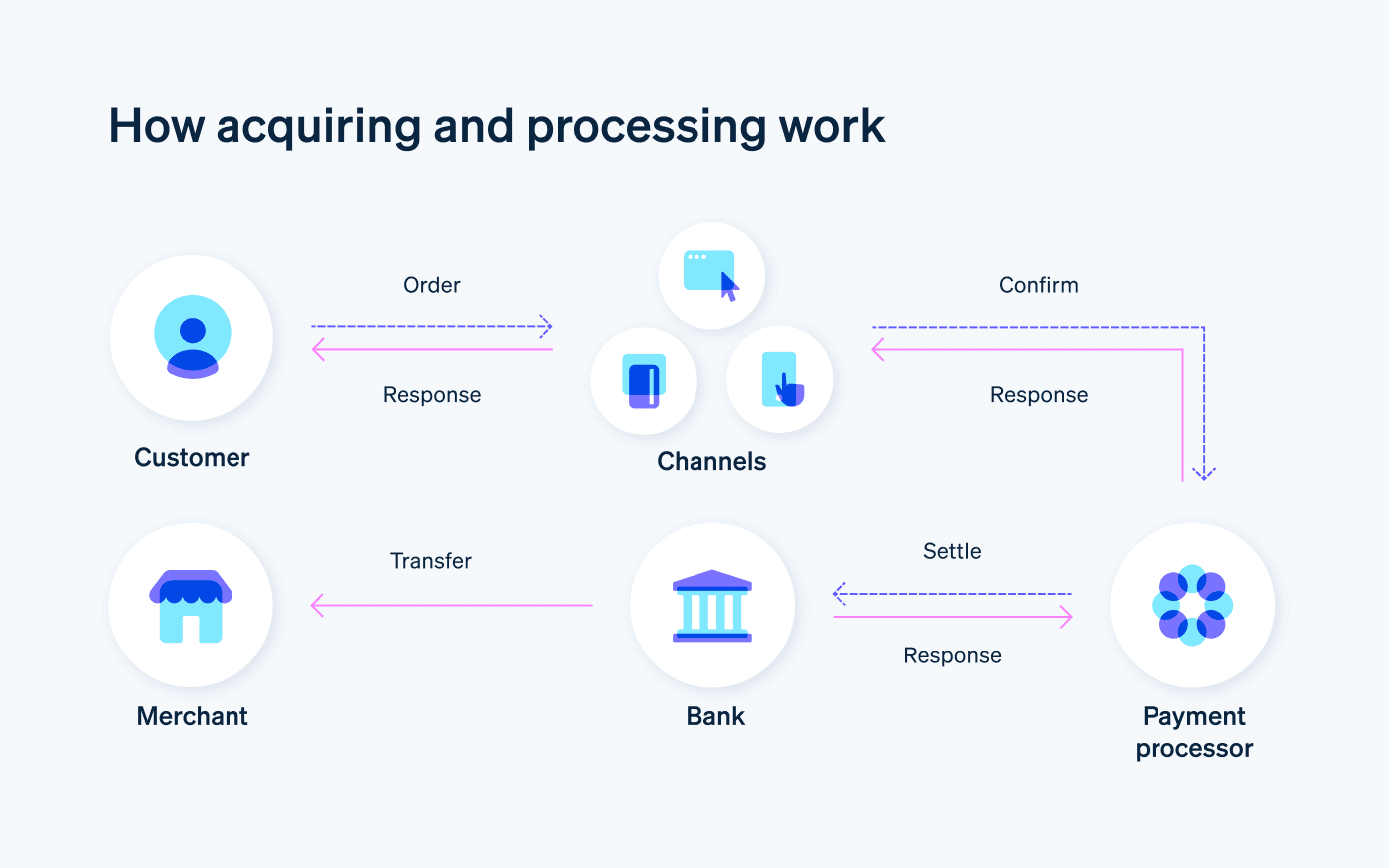一般来说,订阅业务因付款失败导致的损失占收入的 9%。这些损失可能源于交易被拒绝、处理错误或支付路径效率低下,所有这些都会影响客户关系、业务运营和收入。为了促进每个渠道的支付并确保良好的客户体验,企业必须了解支付处理商和收单机构等关键参与者的角色,这些参与者的协作使数字支付成为可能。混淆这些实体会导致支付设置效率低下、手续费增加以及交易失败风险增加。
在本文中,我们将探讨支付处理商和商家收单机构:它们的区别、它们的独特职能以及它们在支付过程中如何协同工作。我们还将介绍 Stripe 的一体化支付服务方法如何简化企业的支付处理。
目录
- 什么是支付处理商?
- 什么是商家收单机构?
- 支付处理商和收单机构之间的区别
- 支付处理商和收单机构如何协同工作?
- Stripe 客户是否需要有单独的收单机构?
- Stripe 如何处理支付处理和收单机构
什么是支付处理商?
支付处理商是通过处理和授权信用卡、借记卡和其他数字支付方式(如数字钱包)促进电子交易的公司或服务机构。支付处理商的主要职能是验证交易明细,确保资金的可用性,并在客户账户和企业银行账户之间安全地转移资金。
其运作机制如下:
- 当客户进行购买时,支付处理商会捕获付款详细信息并将其转发给必要的金融机构进行审批。
- 处理商与客户的发卡机构或银行卡组织(例如 Visa 或 Mastercard)进行通信,以确认资金可用性并检测潜在的欺诈行为。
- 一旦交易获得批准,支付处理商就会协助将资金从客户账户安全地转移到企业的商家账户。
支付处理商还帮助企业遵守 PCI DSS 等合规标准,以保护敏感的支付数据并降低欺诈风险。
什么是商家收单机构?
收单机构也称为收单行或商家收单机构,它是与企业合作处理信用卡和借记卡交易的金融机构。它充当企业、支付处理商和发卡行之间的中介,确保电子交易得到授权、处理和安全结算。在电子支付方面,收单机构通过以下方式发挥着重要作用:
1.建立和维护商家账户,允许企业接受银行卡付款
2.推动企业与发卡行或发卡机构(向客户发行信用卡或借记卡的银行)之间的交易授权和结算
3.承担拒付、欺诈风险和银行卡交易中的争议
当客户进行银行卡支付时,收单机构将交易请求发送给发卡行(发行客户信用卡或借记卡的银行)。如果发卡行批准了交易,收单机构将完成付款,并确保资金在几个工作日内存入企业的商家账户。
没有收单机构,企业将无法高效地处理银行卡支付或管理结算。
支付处理商和收单机构之间的区别
支付处理商和收单机构在整个支付处理系统中扮演着不同的角色,各自在协助完成客户和企业之间的交易方面发挥着独特的作用。虽然它们的角色乍看起来相似,但了解它们在系统中的各自职能和关系非常重要。
下面总结了支付处理商和收单机构之间的主要区别:
在交易过程中的角色:
支付处理商:支付处理商通过验证交易明细、检查资金可用性以及在客户和商家账户之间安全地转移资金,协助完成和授权客户与企业之间的电子交易。
收单机构:收单机构与企业合作处理信用卡和借记卡交易,并负责建立和维护商家账户;协助对与发卡行的交易进行授权和结算;并承担拒付、欺诈和争议的风险。
与企业的关系:
支付处理商:支付处理商作为企业的服务提供商,代表企业处理和授权交易。企业与处理商没有直接关系,但与支付服务提供商有直接关系,支付服务提供商充当企业与支付处理商之间的中介。在某些情况下,支付处理商和支付服务提供商是同一实体,例如 Stripe。在这些情况下,企业确实与处理商有直接关系。
收单机构:通过提供和管理商家账户,收单机构与企业有直接关系。收单机构负责承保商家账户,并在发生争议或拒付时承担一定程度的风险。同样,如果企业与像 Stripe 这样的综合支付服务提供商合作,则无需与单独的收单机构合作。下面,我们将详细讨论 Stripe 如何提供这种组合功能。
与银行卡组织和发卡行的关系:
支付处理商:支付处理商与银行卡组织和发卡行进行通信,以验证和授权交易。处理商通常与多个收单机构签订协议,并充当收单机构和企业之间的中介。
收单机构:收单机构与银行卡组织和发卡行进行通信,以授权和结算交易。收单机构是银行卡组织的成员,并签订了代表银行卡组织处理交易的协议。
支付处理商和收单机构实体都是实现顺利而安全的电子支付流程的关键。支付处理商处理的是处理和授权交易的技术方面,而收单机构则管理金融部分,包括建立商家账户和促进与发卡行的通信。
支付处理商和收单机构如何协同工作?
支付处理商和收单机构是电子支付生态系统的重要组成部分,共同确保客户和企业之间的交易高效、安全。这两个实体之间的密切合作可以分解为以下步骤:
交易发起
当客户使用信用卡或借记卡发起支付时,企业的支付网关会安全地捕获交易明细并将其传输到支付处理商。交易授权
支付处理商将交易信息转发给收单机构,收单机构将其发送给银行卡组织。银行卡组织将交易转到发卡行进行授权。批准或拒绝
发卡行会验证银行卡的详细信息,并检查客户账户中的资金可用性。基于这些因素,发卡行要么批准交易,要么拒绝交易。此响应通过银行卡组织、收单机构和支付处理商发送回企业。结算
如果交易获得批准,发卡行将资金转给收单机构。收单机构通常会在几个工作日内将资金存入商家账户。支付处理商确保交易数据被准确记录并传输给各方。
在整个过程中,支付处理商和收单机构协同工作,分别管理交易的技术和财务方面。支付处理商管理交易数据的授权和安全传输,而收单机构管理商家账户,授权与发卡行进行交易,并促进资金结算。

Stripe 客户是否需要有单独的收单行?
Stripe 是一个支付处理平台,既是支付处理商,又是收单行。当企业注册 Stripe 时,不需要有单独的收单行或建立单独的商家账户。Stripe 处理电子支付处理的所有方面,从交易授权到资金结算。
作为一家全栈支付服务商,Stripe 通过将支付处理商和收单行的角色合并到一项服务中,简化了企业的支付流程。这意味着使用 Stripe 的企业可以接受不同形式的数字支付,包括信用卡和借记卡,而无需与多个实体建立关系。
Stripe 如何处理支付处理和收单行
通过将支付处理和收单功能集成到一个平台中,Stripe 简化了企业的电子支付流程。下面介绍 Stripe 如何处理支付处理和收单:
入驻
当企业注册 Stripe 时,它会创建一个 Stripe 账户,该账户实际上充当其商家账户。该账户允许企业接受各种形式的数字支付,包括信用卡和借记卡,而无需单独的收单行或商家账户。交易流程
当客户在公司的网站或应用上发起付款时,Stripe 的集成支付网关会安全地捕获交易明细并将其转发到 Stripe 的处理基础设施。交易授权
作为支付处理商和收单行,Stripe 与卡组织和发卡行沟通,以验证交易明细并检查资金的可用性。批准或拒绝
发卡行根据银行卡详细信息和可用资金批准或拒绝交易。此响应通过卡组织发送回 Stripe,后者将决策转发给企业。结算
如果交易获得批准,Stripe 会协助将资金从发卡行转移到企业的 Stripe 账户。然后,Stripe 将资金转入企业的指定企业银行账户,这称为提现,通常需要几个工作日内。
通过结合支付处理商和收单行的角色,Stripe 为企业提供全面、集成的解决方案来接受、处理和管理电子支付。这种一体化方法简化了支付流程,减少了支付环境中对多种关系的需求,并简化了企业及其客户的整体体验。要了解更多信息并开始使用,请访问此页面。
本文中的内容仅供一般信息和教育目的,不应被解释为法律或税务建议。Stripe 不保证或担保文章中信息的准确性、完整性、充分性或时效性。您应该寻求在您的司法管辖区获得执业许可的合格律师或会计师的建议,以就您的特定情况提供建议。